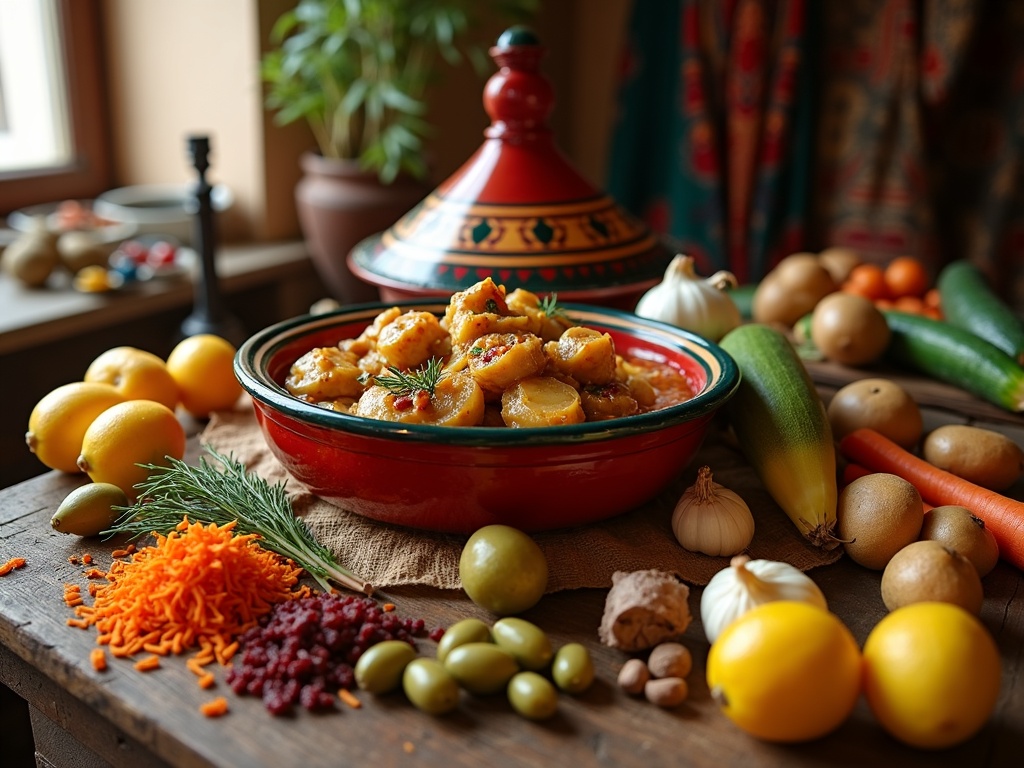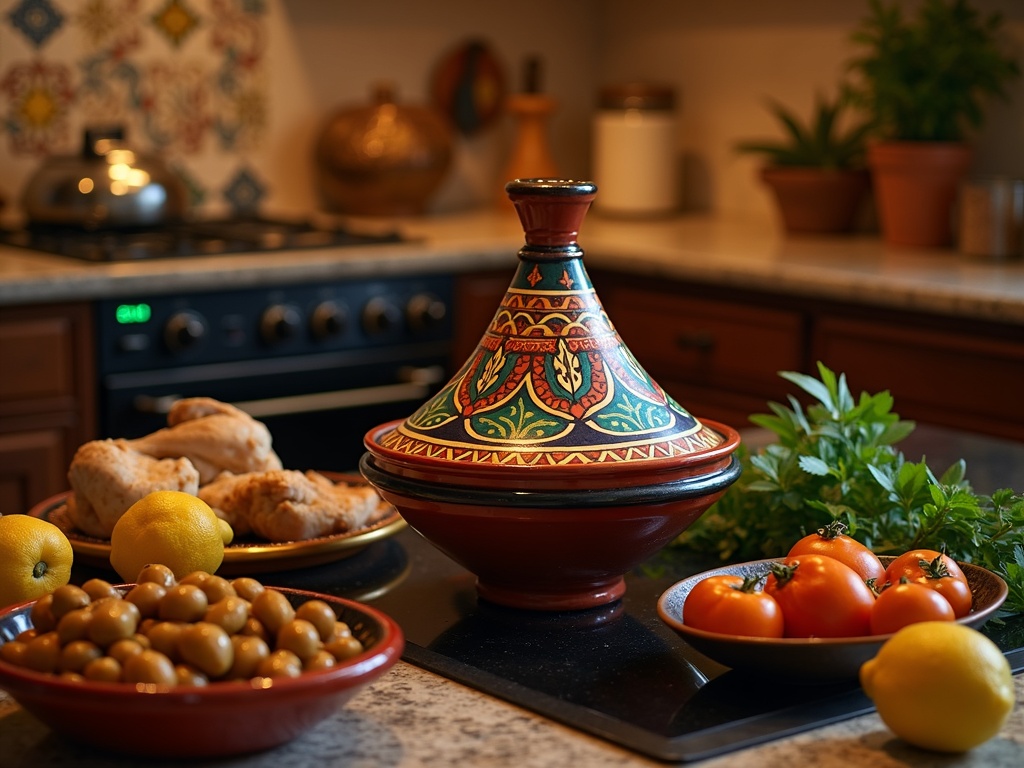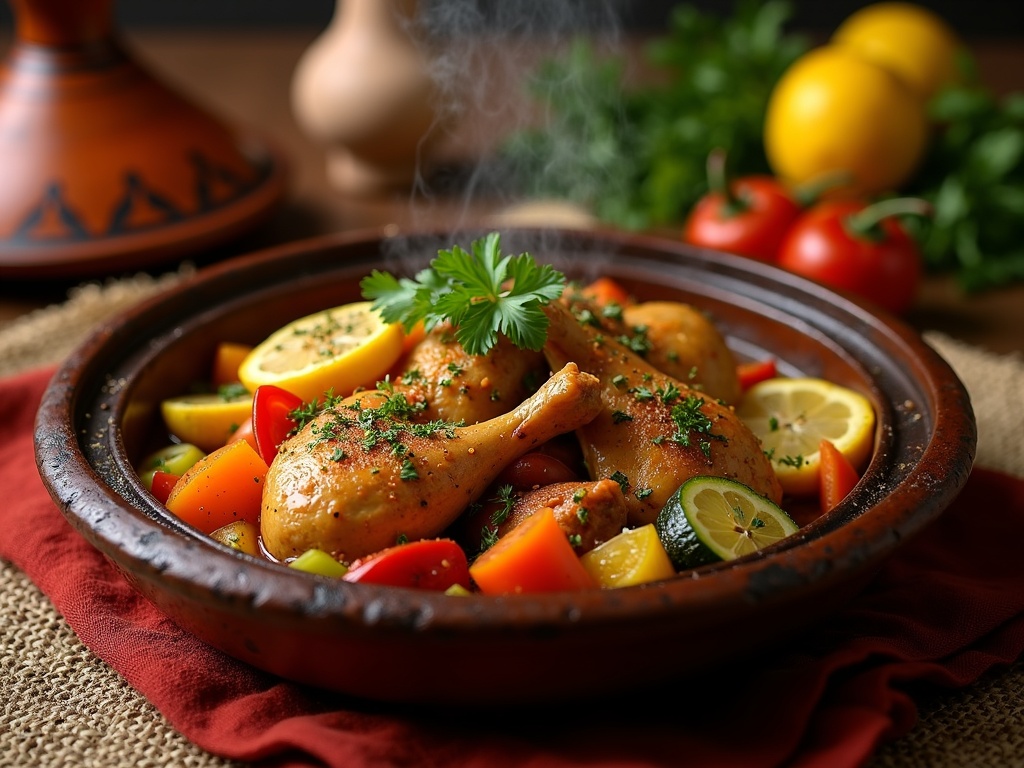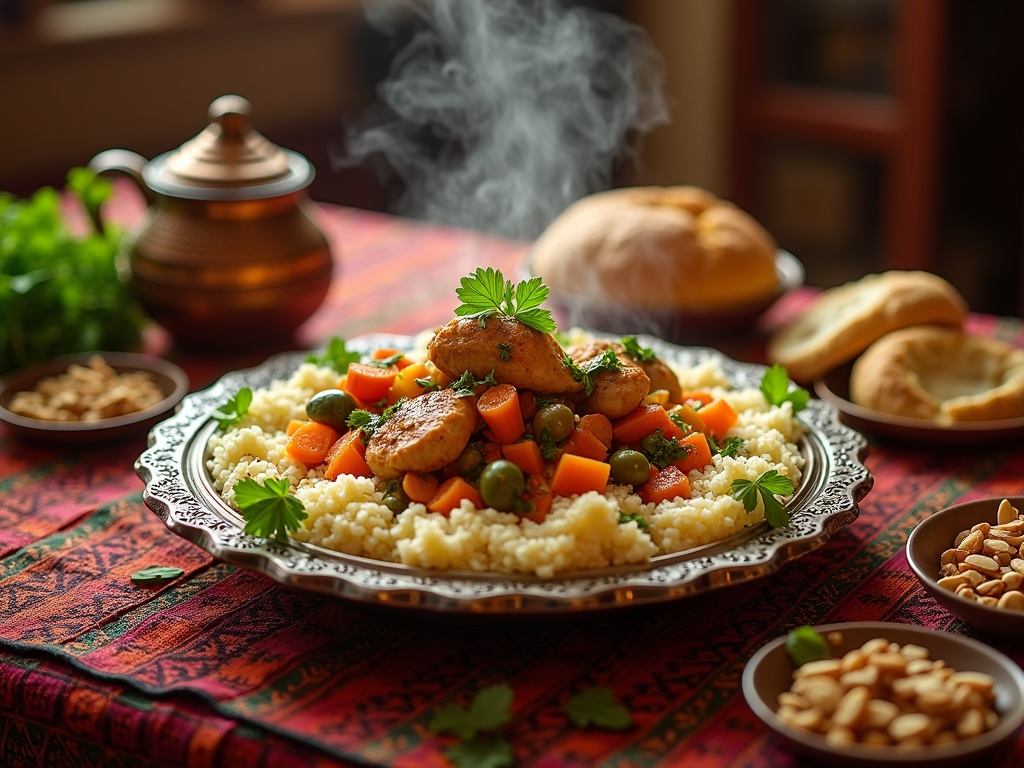Chicken tagine stands as North Africa’s culinary masterpiece, where its cone-shaped cooking pot creates a steam circulation system that yields tender meat and layered flavors. This slow-cooked dish originated in ancient Berber cooking, where cooks mastered turning basic ingredients into flavorful meals that remain essential to Moroccan culture and hospitality.
Find In This Article
Key Takeaways
- The traditional tagine pot’s conical lid creates a natural condensation cycle that keeps food moist while imparting subtle earthy flavors impossible to replicate in modern cookware.
- Authentic chicken tagine relies on a special combination of ingredients including preserved lemons, olives, aromatic spices like saffron, and dried fruits that create a perfect sweet-savory balance.
- Cooking temperature is critical for success, with a gentle heat (medium-low on stovetop or 325°F in the oven) allowing the chicken to slowly release flavors and become fork-tender.
- The dish offers impressive nutritional benefits, providing approximately 25g of protein per serving along with heart-healthy fats and antioxidant-rich spices like saffron, ginger, and turmeric.
- Traditionally served communally atop fluffy couscous with fresh herb garnishes, chicken tagine represents not just a meal but a cornerstone of Moroccan hospitality and cultural identity.
The Ancient Art of Moroccan Tagine Making
The distinctive conical lid of an earthenware tagine pot isn’t just aesthetically pleasing—it’s engineering genius. This traditional cooking vessel creates a unique steam circulation system that returns condensation to the bottom of the pot, resulting in incredibly tender meat and vegetables. I’ve found that authentic tagines impart a subtle earthy flavor that’s impossible to replicate in modern cookware.
Chicken tagine represents one of North Africa’s most celebrated culinary treasures. This dish traces its origins to ancient Berber cuisine, where resourceful cooks perfected the art of slow-cooking to transform simple ingredients into complex flavor profiles. The technique has been passed down through generations, preserving cultural heritage through food.
The Slow-Cooking Magic
The beauty of chicken tagine preparation lies in its unhurried approach. Traditional tagine cooking requires patience:
- Marinating the chicken with spices (typically 2-4 hours or overnight)
- Initial browning of meat and aromatics (15-20 minutes)
- Slow simmering under the conical lid (1-2 hours)
- Final resting period to allow flavors to meld (15-30 minutes)
This slow-cooking method allows tough cuts of meat to become fork-tender while spices infuse every bite. Unlike quick-cooking methods, a properly prepared chicken dish in a tagine develops layers of flavor impossible to achieve through faster techniques.
Tagine isn’t just a meal in Morocco—it’s a cornerstone of cultural identity. The communal aspect of sharing a tagine directly from the cooking vessel holds profound significance during family gatherings, weddings, and Ramadan celebrations. The central placement of the tagine pot symbolizes unity and togetherness.
The dish plays a key role in Moroccan hospitality traditions. Offering guests a flavorful chicken meal prepared with care demonstrates respect and honor. I’ve learned that Moroccan hosts often prepare their finest tagine recipes when welcoming visitors, showcasing both culinary skill and generosity.
The versatility of tagine cooking allows for endless chicken variations based on regional ingredients and family traditions. From the saffron-infused tagines of Fez to the olive-rich versions of Marrakech, each region offers its own interpretation of this beloved dish.
Essential Ingredients That Make It Special
Authentic chicken tagine relies on a special combination of ingredients that transport your taste buds straight to Morocco. I’ve found that understanding these key components helps create that distinctive flavor profile that makes this dish so beloved around the world.
The Foundation of Flavor
The soul of chicken tagine begins with its traditional base ingredients. Preserved lemons deliver a unique tangy brightness that’s impossible to replicate with fresh lemons. These salt-cured citrus gems add depth and complexity that transforms the entire dish. I always pair them with plump olives that provide a briny contrast to the sweet elements.
Aromatics like onions and garlic form the backbone of the tagine, slowly caramelizing to release their natural sweetness. This creates a rich foundation for the other flavors to build upon.
The signature spice blend truly sets tagine apart from other chicken dishes. Saffron threads add their distinctive floral notes and gorgeous golden hue, while warming ginger and cinnamon bring comfort and depth. These spices don’t just flavor the dish—they create an aromatic experience from the moment the chicken stock begins to simmer.
Regional variations exist across Morocco, with coastal areas often favoring saffron while inland regions might incorporate more cayenne for heat. This flexibility allows you to adjust the spice level to your preference.
Sweet and Savory Balance
The magic of tagine lies in its perfect sweet-savory balance. Dried fruits like apricots and raisins slowly release their natural sweetness into the sauce, creating a complex flavor that complements the savory chicken perfectly. I find this contrast particularly delightful when the chicken becomes tender after slow cooking.
Fresh vegetables add both nutrition and texture to complete the dish. Carrots provide earthy sweetness while zucchini absorbs the fragrant sauce. Some versions incorporate potatoes or sweet potatoes for heartiness, especially in chicken recipes designed for family gatherings.
The combination of these ingredients creates layers of flavor that continue to develop as the tagine simmers. Each component plays an essential role in building that distinctive Moroccan profile that makes this dish so special.
When preparing chicken tagine at home, I focus on sourcing the best quality ingredients possible. While some items like preserved lemons might require a trip to a specialty store or online order, the depth of flavor they provide makes the effort worthwhile for an authentic chicken experience.

The Perfect Way to Cook Your Tagine
Cooking a chicken tagine requires understanding the unique steam circulation that happens within this cone-shaped cooking vessel. I’ve found that the design creates a natural condensation cycle that keeps food moist with minimal added water. When preparing chicken stock for tagine, I use only about half a cup of liquid since the tagine’s design naturally preserves moisture.
Stovetop vs. Oven Methods
The cooking method you choose significantly impacts your tagine’s final flavor profile. On the stovetop, I maintain direct control over the heat, making it easier to adjust temperatures as needed. This method works perfectly when I want to check seasoning or tenderness without disrupting the cooking process.
Oven cooking, however, provides more consistent heat distribution. I prefer this method when making traditional chicken dishes that need slow, even cooking. The oven creates an environment where the tagine can work its magic undisturbed, resulting in deeper flavor development.
Both methods produce excellent results, but stovetop cooking requires more attention to prevent scorching, while oven cooking needs proper temperature settings from the start.
Temperature and Timing Essentials
Controlling temperature is critical for tagine success. I start with a gentle heat—never exceeding medium-low on stovetop or 325°F (163°C) in the oven. This slow approach allows the chicken pieces to release their flavors gradually without toughening.
Cooking times vary based on the size of your chicken pieces:
- Bone-in chicken thighs: 60-75 minutes
- Boneless chicken thighs: 45-55 minutes
- Chicken breast pieces: 35-45 minutes
- Whole cut-up chicken: 75-90 minutes
The tagine is ready when the meat easily pulls away from the bone and the sauce has thickened slightly. Traditional Moroccan cooks teach that the dish should never boil rapidly—just a gentle simmer produces the most tender chicken for any recipe.
I’ve learned that authentic tagine preparation involves a technique called “building the tagine”—layering ingredients strategically. The tougher vegetables and bone-in chicken pieces go at the bottom where heat is highest, while delicate items like preserved lemon and olives are added toward the end of cooking.
One traditional technique passed through generations involves rubbing the interior of a new clay tagine with chicken fat before its first use, then soaking it overnight. This seasoning process prevents cracking and improves cooking performance over time, much like caring for cast iron cookware.

Health Benefits and Nutrition Facts
Chicken tagine isn’t just a flavor explosion—it’s also a powerhouse of nutrition that delivers solid health benefits while remaining relatively moderate in calories. A typical 1-cup serving contains about 300-400 calories, making it a reasonable option for those watching their caloric intake without sacrificing satisfaction.
I’ve found that chicken tagine offers an impressive protein punch, with approximately 25g per serving. This makes it an excellent choice for muscle maintenance and repair. The dish contains around 15g of fat per serving, which primarily comes from olive oil and the chicken itself—mostly heart-healthy unsaturated fats when prepared traditionally.
Nutrient-Rich Ingredients
The impressive nutritional profile of chicken tagine comes from its varied ingredients:
- Saffron, the precious golden spice, contains powerful antioxidants that help combat oxidative stress in the body. I’ve noticed that even small amounts can add both flavor and health benefits to the dish.
- Ginger plays a key role in chicken stock foundation for tagine and offers significant anti-inflammatory properties that may help reduce joint pain and muscle soreness.
- Turmeric, commonly included in many tagine recipes, contains curcumin—a compound with powerful anti-inflammatory effects.
- Preserved lemons provide vitamin C and antioxidants while adding that distinctive tanginess to chicken dishes like tagine.
- Vegetables such as carrots, bell peppers, and zucchini add essential vitamins, minerals, and fiber to the meal.
The olive oil used in tagine preparation is rich in monounsaturated fats and contains polyphenols that support heart health. When I make chicken with aromatic spices, I always use quality olive oil as the base.
Herbs and spices like cilantro, parsley, cumin, and coriander aren’t just flavor enhancers—they’re packed with antioxidants and have various medicinal properties. The combination of these ingredients creates a dish that’s not only satisfying but also nutritionally dense.
Another benefit of chicken tagine is its slow-cooking method, which helps preserve nutrients that might be lost in high-heat cooking techniques. The gentle simmering allows flavors to develop fully while maintaining the integrity of the ingredients.
For those looking to boost their vegetable intake, tagine is incredibly versatile. I often incorporate chickpeas for additional protein and fiber, making the chicken more hearty and nutritionally balanced.
The balanced combination of protein, healthy fats, and complex carbohydrates in chicken tagine also helps maintain steady blood sugar levels and provides sustained energy. When I serve it with whole grain couscous instead of white, I get the added benefit of additional fiber and nutrients.
For those concerned about sodium, it’s worth noting that traditional chicken recipe variations like tagine can be adjusted to reduce salt content without compromising flavor, thanks to the abundant spices used in its preparation.
The beauty of chicken tagine lies in its perfect balance—it’s comforting and satisfying while delivering significant nutritional benefits, making it a smart choice for both everyday meals and special occasions.

Serving Your Tagine Like a Moroccan
The final presentation of chicken tagine transforms a delicious meal into a genuine Moroccan dining experience. I’ve found that the traditional approach to serving this aromatic dish creates an atmosphere that honors its rich heritage while delighting everyone at the table.
Traditional Pairings and Garnishes
Chicken tagine traditionally sits atop a bed of fluffy couscous, which conveniently absorbs all those wonderful spiced juices. With only 150 calories per cup, couscous provides a light yet satisfying base that complements the hearty nature of the tagine. I prepare my couscous separately, allowing it to steam to perfection before arranging it on a decorative platter as the foundation for the tagine.
Fresh herbs are essential for both flavor and visual appeal. A generous sprinkling of chopped cilantro and flat-leaf parsley adds bright color and fresh flavor that cuts through the richness of the dish. For an authentic touch, I add toasted almonds or sesame seeds just before serving, creating textural contrast and a nutty flavor that enhances the chicken stock-based sauce.
In Moroccan homes, tagine is typically served communally, creating a shared dining experience that brings people together. The dish arrives at the center of the table where everyone eats from the same platter, typically using bread or their right hand instead of utensils. While you might prefer to adapt this tradition with individual servings, maintaining the communal spirit honors the dish’s origins.
The presentation makes a significant impact on the dining experience. Serve your chicken dish on a decorative platter with intricate Moroccan patterns if available. The vibrant colors of the tagine – the orange from carrots, green from olives, and red from preserved lemons – create a feast for the eyes before the first bite.
Complementary side dishes enhance the meal further. Consider serving warm, fresh bread for scooping up sauce, a simple cucumber and tomato salad dressed with lemon juice and olive oil, or pickled vegetables for acidity. A refreshing mint tea, served in small glasses before or after the meal, completes the authentic chicken dinner experience.

Sources:
“The Food of Morocco” by Paula Wolfert
“Cooking at the Kasbah” by Kitty Morse
“The New Moroccan” by Doug B-lib
“Moroccan Cuisine and Culinary Traditions”

